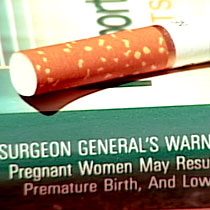-
(单词翻译:双击或拖选)
Washington
25 April 2007
Do warning labels about health hazards on cigarettes help people to quit smoking? New research shows they at least cause people to think about what they are doing.
The World Health Organization is concerned that the money used to treat cancer and other diseases caused by tobacco could be better used to treat diseases that are not currently preventable.
VOA's Carol Pearson reports on an international effort to reduce smoking.
A leading researcher predicted, "A billion people are projected to be killed by tobacco use throughout the world this century."
Psychologist Geoffrey Fong heads a major international study to evaluate tobacco control policies in more than 100 countries.
He cites statistics that show smoking as the second leading cause of death in the world, a cause of death and suffering that can be prevented.
 |
| Warning label on cigerettes sold in U.S. |
But Fong's research shows the effectiveness of the labels varies greatly.
In the United States, warning labels are printed on the side of the cigarette package.
And here is what some smokers1 at the Voice of America say about these labels.
One man says, "I know it's there, but I don't look at it." Another remarked, "You know, I don't pay a lot of attention to the warning labels here in the United States, because I don't even see it.
Fong's research shows theirs is the typical American's response.
Now, look at what Canadians see when they smoke: graphic2 images of gum disease, lung cancer, children and babies subject to second hand smoke, and information about tobacco... that it can be harder to quit cigarettes than quitting heroin3 or cocaine4.
Images that cover half the cigarette pack are hard to ignore.
Mil Arcega, a Canadian, agrees. "I do recall every time I looked at these warning labels, I would have to stop and think, oh my God, because these warning labels are so scary."
For warning labels to be effective, research shows they have to make you react emotionally. That is a tool tobacco companies use to sell cigarettes.
Professor Paul Slovik from the University of Oregon adds, "Of course, tobacco advertisers and marketers have known this for years. That's the whole centerpiece for their advertising5 -- to get people to associate very positive imagery, you know, beautiful people doing exciting things in beautiful places with their cigarette product."
Professor Slovik co-authored another study that shows warning labels and other media can reduce the number of teenagers who smoke. They also can encourage smokers to quit.
The World Health Organization is sponsoring a treaty to require warning labels to cover at least a third of the front and back of cigarette packs. Out of the 168 countries to signed the treaty, 145 have ratified6 it. The United States signed the treaty but did not ratify7 it.
 收听单词发音
收听单词发音
1
smokers

|
|
| 吸烟者( smoker的名词复数 ) | |
参考例句: |
|
|
|
2
graphic

|
|
| adj.生动的,形象的,绘画的,文字的,图表的 | |
参考例句: |
|
|
|
3
heroin

|
|
| n.海洛因 | |
参考例句: |
|
|
|
4
cocaine

|
|
| n.可卡因,古柯碱(用作局部麻醉剂) | |
参考例句: |
|
|
|
5
advertising

|
|
| n.广告业;广告活动 a.广告的;广告业务的 | |
参考例句: |
|
|
|
6
ratified

|
|
| v.批准,签认(合约等)( ratify的过去式和过去分词 ) | |
参考例句: |
|
|
|
7
ratify

|
|
| v.批准,认可,追认 | |
参考例句: |
|
|
|















